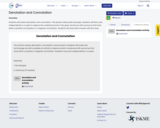
English Instructional Plan – Crowd Sourcing False Premise Analysis and Rewriting for Clarity
- Subject:
- English
- Reading
- Material Type:
- Lesson Plan
- Author:
- VDOE Project Team
- Date Added:
- 04/22/2022

English Instructional Plan – Crowd Sourcing False Premise Analysis and Rewriting for Clarity

A link to a primary source set followed by a project focused on modern-day types of hysteria that will provide students with a greater understanding of the sociopolitical contexts of the play

English Instructional Plan – Grades 9- 12: Current Events Persuasive Debate and Essay

This is day 2 of a whole group phonics r-controlled short vowel lesson. There are 4 total days. In this lesson you will find:Phonogical Awareness Warm UpWord Feature HighlightChunk-Chunk-BlendsVideo Resources

This is day 3 of a whole group phonics r-controlled short vowel lesson. There are 4 total days. In this lesson you will find:Phonogical Awareness Warm Up, Word Feature Highlight, Chunk-Chunk-Blends, Video Resources, and Decodable Text.

This is day 4 of a 4 day lesson. This lesson is on Whole Group phonics, instruction on R-Controlled Short Vowels in single syllable words. This rescource includes:- Phonological Awareness Warm Up- Word List to highlight feature- Chunk, Chunk, Blend Cards-Decodable Text

This video is part of the Continue to Know with WHRO TV series. Watch Jadah Jones teach about using reference materials.

Students will review denotation and connotation. The teacher will provide examples. Students will then work independently or in pairs to replace the underlined words in the given sentences with synonyms that have either a positive connotation or a negative connotation. Students will share their answers with the class.

English Instructional Plan- Describing Characters

English Instructional Plan-Developing Objective Summaries 6

This video is part of the Continue to Know with WHRO TV series. Watch Beth Eanes teach about four different organizational patterns in text structures.

English Instructional Plan Direct and Indirect Characterization 6-8

When do I teach this strategy? When beginning readers need more practice in self-monitoring and looking through the whole word.Purpose/Behavior: Students practice self-monitoring by reading the sentences and cross-checking the picture to determine which sentence “makes sense,” without prompting.

When do I teach this strategy? When beginning readers need more practice in self-monitoring and looking through the whole word.Purpose/Behavior: Students practice self-monitoring by reading the sentences and cross-checking the picture to determine which sentence “makes sense,” without prompting.

When readers are NOT self-monitoring and recognizing when what they read does not “sound right,” and/or “make sense.”Students practice self-monitoring by reading the sentences and cross-checking meaning to determine which sentences “sound right,” and “make sense,” without prompting.

When do I teach this strategy? When readers are NOT self-monitoring and recognizing when what they read does not “sound right,” and/or “make sense.”Purpose/Behavior: Students practice self-monitoring by reading the sentences and cross-checking meaning to determine which sentences “sound right,” and “make sense,” without prompting.

Learn about inspirations for a story and how that story can inspire a new song. Mary and Mike travel to the Music Resource Center in Charlottesville to meet up with the author, Marc Boston, and the musician, Tevin White. Marc shares his beautiful children’s book, inspired by his own daughter. And Tevin shares a special song that he wrote, inspired by Marc’s book. Together, we learn how to stop carrying so much stuff!

Students will listen to the story Two Bad Ants by Chris Van Allsburg and use clues from the text to draw conclusions about the events of the story. Students will create a storyboard to represent the events of the story and use their storyboard to construct a program to sequence Two Bad Ants.

English Instructional Plan –Drawing conclusions and making inferences: Crime scene analysis

Following a brief warm-up routine where students pretend to be a plant reacting to sunlight and water, students learn motions representing a period, question mark, and exclamation mark. As our narrators read ten sentences, students perform the motion that matches the appropriate end punctuation for each sentence.